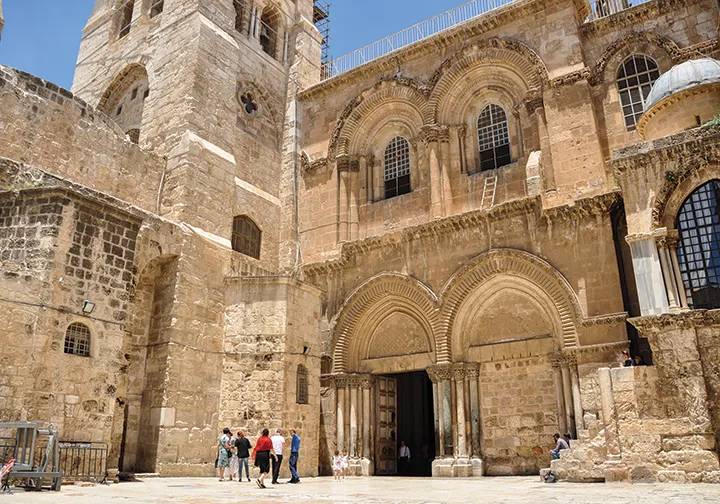
by Joe Bollig
joe.bollig@theleaven.org
KANSAS CITY, Kan. — Annually during the penitential season of Lent, Catholics undertake many devotional and liturgical practices in preparation for Easter, the principal feast of the liturgical year.
One beloved and ancient devotion is praying the Stations of the Cross, also called the Way of the Cross (“Via Crucis”) or the Sorrowful Way (“Via Dolorosa”).
This devotion grew out of a desire by Christians to visit the places associated with Christ’s life, and in this case, the final acts of Jesus’ passion culminating in his crucifixion and burial.
Over time, pilgrims began to follow a route in Jerusalem — the Via Dolorosa — between the Antonia Fortress, where Jesus was condemned to death and began to carry his cross, to Golgotha and Jesus’ tomb, now the Church of the Holy Sepulcher.
They would stop at various places associated with the events of Christ’s passion to pray. These eventually became known as “Stations.”
There have been many things that have influenced the development of the devotion over time.
One of those was the legalization of Christianity in 312 by the Emperor Constantine. Because of him, Christians could openly practice their faith and build churches. Another was the growing practice of pilgrimage to the Holy Land by Christians living in various countries.

St. Jerome, who died 420 in Bethlehem, wrote about pilgrims from different countries visiting the holy places.
Christian pilgrimages to the Holy Land became difficult after the Muslim conquest of formerly Byzantine Christian Jerusalem in 638, until conquest by European Crusaders in 1099.
After the Muslim reconquest of Jerusalem in 1187, it became difficult and often impossible once again for Christians to go on pilgrimage to the holy places. The Muslims placed many restrictions on Christians, including prohibiting them from traveling and praying as they walked the Via Dolorosa.
In any era, going on pilgrimage to the Holy Land was a long, difficult and dangerous undertaking. Most Christians could not go on pilgrimage to the Via Dolorosa.

St. Francis of Assisi and the Franciscan Friars began to play a key role in the development of the devotion, however, when the Franciscans became guardians of Holy Land shrines in 1342. Because of Muslim restrictions, the Franciscans began to popularize the Via Dolorosa devotions in various countries by erecting Stations, with papal approval.
In 1686, Pope Innocent XI decreed that the indulgences, previously granted by praying the devotion in Jerusalem, could be given to the faithful praying the local Stations of the Cross.
The names and numbers of the Stations have varied as the devotion developed, but Pope Clement XII fixed them in 1731. Traditionally, there are 14 Stations, although a modern practice of adding a 15th — the Resurrection — arose after the Second Vatican Council ended in 1965.
The traditional Stations of the Cross come from the Gospels, but also non-biblical traditions. In 1991, Pope John Paul II introduced a new Scriptural Way of the Cross, keeping some traditional Stations and adding some new.
Sources:
• Fr. William Sanders, Arlington Catholic Herald
• Fr. Johann G. Roten, University of Dayton • Catholic Encyclopedia, newadvent.org
• usccb.org
A Franciscan pilgrimage to the Holy Land
If you look in any church or chapel in the Archdiocese of Kansas City in Kansas, you will find the Stations of the Cross on its walls. To help readers better understand and appreciate this devotion, The Leaven asked assistant professor Andrew Salzmann, of the Department of Theology at Benedictine College in Atchison, to answer a few questions:
Q. What are the Stations of the Cross?
A. The Stations of the Cross are a prayerful journey through 14 (and sometimes 15) moments during the final hours of Our Lord as he gave his life for us on that first Good Friday. Like any devotion, the purpose is to have us remember a truth of our faith and allow that memory to help us grow in love of Christ and all who suffer.
Q. When and where did the Stations of the Cross originate?
A. From early in Christian history, there has been a desire by Christians to go to the Holy Land and see the actual places where Our Lord lived and died, so they could experience with full intensity what Jesus’ life was like. A particular place the pilgrims went in Jerusalem was the Via Dolorosa, which traces Christ’s journey to Calvary and the place where he was buried.
This experience of being directly at those places where the mysteries of our faith happened was so powerful that they wanted to share that pilgrimage experience with those who could not make the journey.
The Franciscans appreciated the power of the imagination to make the life of Christ real to us in a powerful way, so they gave us the Nativity scene so we could relive the moment of Christ’s birth. In the same way, the Franciscans — because they have a special connection to the Holy Land — also gave us the Stations of the Cross so we could imaginatively enter the events of Christ’s death.
When the Crusader kingdoms were defeated by the Muslims, and the Holy Land became inaccessible to Christian pilgrims, that increased the need to find another way for Christians to experience the Holy Land.
And so, the Franciscans brought the Stations of the Cross to Europe as a miniature pilgrimage to the Holy Land. It wasn’t until the 1700s that the traditional order was fixed. Today, we sometimes commemorate different Stations, such as when St. John Paul II celebrated the Scriptural Way of the Cross.
Q. Why should someone pray the Stations of the Cross?
A. The Stations of the Cross help us apprehend the sufferings of Christ by allowing his sufferings to become alive in our imaginations. As we become more aware of his suffering, we become more attentive to the sufferings of those around us. By understanding what Christ’s love for us cost him, it allows us to be, in the words of St. Augustine, “formed by the deformity of Christ, to allow his passion to shape us into cruciform souls, people willing to suffer out of love for those around us.”
Q. Where can the Stations of the Cross be found?
A. Typically, the Stations of the Cross will be 14 pictures or even crosses spaced along the walls of the nave of a church. They can also be found outdoors at retreat centers such as Christ’s Peace House of Prayer in Easton or Prairie Star Ranch in Williamsburg.
When my great-grandmother died, my grandfather’s family drove 300 miles in a Model T to pray the Stations of the Cross outdoors at the Shrine of Mary Help of Christians in Holy Hill, Wisconsin. They prayed for the repose of her soul and to find a deeper meaning in hers and their suffering and to make Christ’s suffering their suffering.
Q. Why do some parishes pray a “15th Station”?
A. The Vatican’s directory on popular piety notes that although the traditional form has 14 Stations, nonetheless we can follow the example of the Via Crucis is Jerusalem, which ends at the place of Christ’s resurrection. And therefore, even in our parishes, the celebration can end with a commemoration of the Lord’s resurrection.
Q. What text is used for the Stations of the Cross?
A. The Vatican’s directory on popular piety notes that there are innumerable texts used for the Stations of the Cross. There is no one way, although we should follow the instructions established by the bishop. The most famous one in the United States is the text written by St. Alphonsus Ligouri.
Q. Can the Stations of the Cross be prayed any time or a special time of the year?
A. Although there are no restrictions as to when we can pray the Stations of the Cross, the church tells us it is most fitting during the season of Lent.
Q. Can the Stations of the Cross be prayed by an individual or in a group?
A. The Stations of the Cross can be prayed both ways, but in either way, the church asks us, if we are able, to walk Station to Station. The Stations can be prayed more or less liturgically, as is done in many parishes during Lent.
Q. Is there an indulgence attached to praying the Stations of the Cross?
A. Yes. The faithful may receive a plenary indulgence if they practice a pious Station of the Cross before legitimately erected Stations. The normal four conditions apply.






